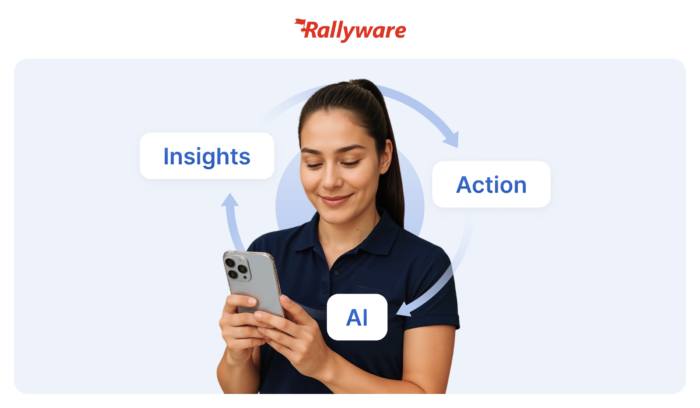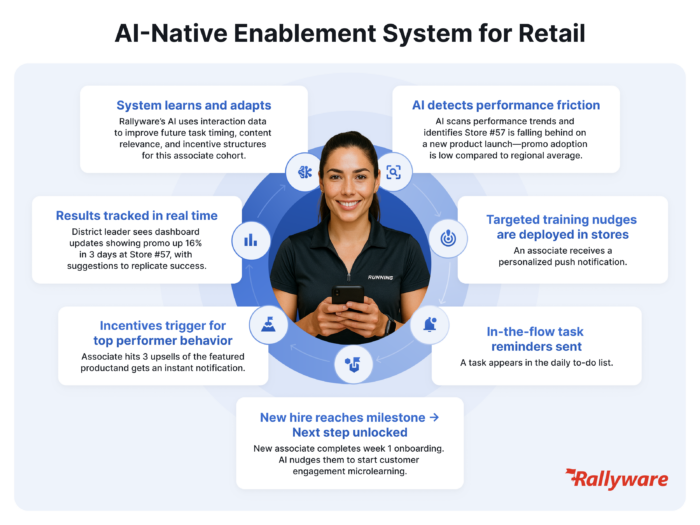5 Innovative Ways Retailers Are Powering Holiday 2025 Through Associate Enablement
Retail AI in 2025: How Intelligent Enablement Is Powering Store Execution
Retailers aren’t just competing on price or product anymore. They’re competing on how intelligently, and consistently, they execute on the floor. In 2025, Retail AI is no longer confined to ecomm algorithms or back-end ops. It’s showing up where it matters most – in real life on the shop floor, between the associate and the customer. From dynamic tasking to predictive inventory, AI is quietly transforming store performance. But intelligence alone isn’t enough.
Sales enablement is how you apply that intelligence. It’s the operational layer that connects AI insights to frontline action, ensuring associates know what to do next, and why it matters.
GenAI Is Reshaping Expectations
A March 2025 consumer survey by Coveo found that 62% of shoppers are more likely to buy when guided by generative AI. That number jumps to 68% for millennials. This shift is making AI not just a nice-to-have, but a frontline expectation. From personalized search to in-store support, genAI is now a driving force in shopping behavior, loyalty, and conversion.
Who’s Doing It Well?
Ulta Beauty: AI-Powered Personalization and Loyalty
Ulta centralized siloed customer data into unified profiles, enabling near real-time personalization through AI. The result? A 95% repeat customer rate and reduced marketing spend. Ulta’s AI-driven loyalty and campaign engine helps associates recommend the right products in the moment, creating 1:1 experiences at scale. (PYMNTS)
Old Navy: Real-Time Inventory Meets AI Execution
As reported in Old Navy’s March 2025 press release, the brand has partnered with RADAR to deploy AI-powered RFID technology across stores nationwide. This enables real-time product tracking, improves associate response time, and supports seamless BOPIS and omnichannel execution.

Image: Gapinc.com
Lowe’s: AI Assistants at Scale
In May 2025, Lowe’s launched Mylow Companion, the first at-scale AI assistant for retail associates. Built in collaboration with OpenAI, it’s designed specifically for the sales floor, delivering expert-level product guidance, inventory lookup, and project advice through voice-enabled, natural language prompts. Whether a new hire or a seasoned pro, every Lowe’s associate can now deliver consistent, high-quality service powered by generative AI. It’s a leap forward in democratizing knowledge and reducing onboarding time.
H&M: Blending Physical and Digital With AI
In an effort to win back share from pure-play ecomm rivals, H&M is leaning into AI to enhance both physical stores and digital experiences. According to WSJ reporting, H&M is using AI to optimize store layouts, product placement, and inventory across a slimmer, more efficient store footprint.
Walmart: Building AI Tools In-House
Walmart is taking a build-not-buy approach equipping 1.5 million U.S. associates with internally developed AI tools. According to their June 2025 announcement, this includes:
- An AI-driven task management system that reduces shift planning time by 67%
- A real-time, 44-language translation tool embedded with Walmart-specific context
- A generative AI assistant for process guidance (e.g., how to process a return)
- RFID + AR tools for visual merchandising guidance in apparel
These solutions are all powered by Walmart’s proprietary ML platform, Element, designed for internal scale and continuous iteration.
From Intelligence to Impact: Why AI Alone Isn’t Enough
The challenge? AI tells you what’s happening. But without a way to guide what should happen next, performance stalls.
That’s where retail workforce enablement comes in. It applies intelligence in real time, triggering the right task, content, or incentive for the right associate at the right moment.
What That Looks Like in Practice
- AI detects a high-return SKU → Enablement pushes updated selling tips to associates
- Low promo adoption in Store 34 → AI flags it → Enablement delivers a targeted incentive
- New hire reaches five-day mark → AI suggests next training step based on performance
Strategy to Execution: A New Sales Enablement Playbook

Having the right AI tools is only half the story. To unlock real value on the store floor, retail leaders need a sales enablement strategy that connects intelligence to impact – every day, at every store.
In our Sales Enablement Strategy post we outline 10 steps that turn AI insights into frontline behavior change. Here’s a preview of how that plays out in retail:
- Behavior-based onboarding: Associates aren’t thrown generic training, they’re guided through ramp-up journeys based on store role, performance, and real-time engagement signals.
- Performance-triggered nudges: When execution lags, the system doesn’t just flag it – it triggers the right learning, communication, or incentive to drive action.
- Adaptive learning paths: Training isn’t a one-time event, it evolves based on region, product mix, and individual KPIs like sales conversion or task compliance.
By tying sales enablement to actual store behaviours, not just learning completion retailers create a performance loop that scales. Execution doesn’t start with tools. It starts with a strategy that turns data into decisions, and decisions into daily habits.
Sales Enablement 3.0: The Retail Layer of AI-Native Performance
Retail doesn’t just need automation. It needs activation, real-time performance systems that close the loop between HQ strategy and the store floor.
Most sales enablement tools in use today were built for a slower, more forgiving era. They track clicks, house PDFs, and assume that knowledge = performance. But today, as George Elfond, CEO of Rallyware states:
“We’re no longer optimizing for content engagement. We’re optimizing for behavior, and behavior is the root of performance.”
George Elfond Sales Enablement 3.0
Here’s how the 3.0 model plays out in retail:
| Enablement Version | Description | Why It Falls Short Today |
| 1.0 | Static content libraries | Too passive. No connection to KPIs. |
| 2.0 | Engagement dashboards | Measures usage, not execution. |
| 3.0 | AI-native performance activation | Triggers the right action, tied to outcomes. |
Modern retail teams need platforms that don’t just store learning, but adapt based on store patterns, team needs, and real-time data.
For example:
- A regional dip in conversion rate triggers a product refresher course for floor teams
- Underperforming stores receive micro-incentives to lift promo execution
- High-performing associates are nudged toward upselling opportunities
This is enablement redefined not as a library or dashboard, but as an intelligent operating layer.
As Gartner notes in its 2025 Sales Enablement Leadership Vision:
“Overwhelmed sellers are 45% less likely to hit quota. Simplifying the seller experience is no longer a nice-to-have. It’s business-critical.”
Gartner Sales Survey
If your frontline tech can’t:
- Detect when action is needed
- Deliver the right nudge
- Learn from outcomes
…it’s not enablement. It’s a content repository. And that’s not enough.
What to Look for in a Retail AI + Enablement Platform

When evaluating platforms for AI-powered retail enablement, the real question isn’t “Which has the most data?” it’s “Which one actually moves the needle in-store?”
A platform can surface dashboards and summaries, but if managers still have to interpret and act manually, that’s not enablement. That’s delay.
You want a system that detects, decides, and delivers, turning intelligence into action at the associate level.
And just as important:
Choose a platform whose AI is trained on deep, relevant retail data, not shallow models built on generic inputs.
Your enablement engine should be learning from thousands of frontline data points, sales patterns, training engagement, and promo adoption, so every nudge, task, or incentive it delivers is context-aware and proven to work.
Look Beyond AI Buzzwords
Many platforms tout AI, but if they’re just surfacing dashboards, you’re still relying on managers to interpret and act. That’s not enablement, it’s analysis paralysis.
What you want is an AI-native performance engine a platform that:
- Detects friction (training gaps, low SKU sales, campaign lag)
- Automatically delivers tasks, learning, or nudges to frontline staff
- Tracks which interventions actually drive performance
Must-Have Capabilities in 2025
| Feature | Why It Matters |
| Mobile-first UX | Store teams don’t work from desktops -your enablement shouldn’t either |
| Behavior-based AI | Recommends content and actions based on actual performance patterns |
| Localization & Flexibility | Works across regions, stores, and brands – without custom dev |
| KPI-Linked Analytics | Connects associate actions to store outcomes (sell-through, speed to ramp, compliance) |
To Build or Buy Retail AI Software? What Retailers Are Choosing in 2025
Some retailers try to build retail software internally – especially with IT pressure to “own the stack.” Walmart is a prime example, with in-house tools built on its proprietary AI platform, Element. But we all know, Walmart’s resources aren’t typical. Walmart often chooses to build instead of buy to:
- Maintain control over proprietary data
- Customize tools at massive scale (1.5M+ frontline employees)
- Continuously iterate and optimize based on real-world store feedback
For most organizations, building equals delays, disjointed tools, and tech debt.
Instead, modern brands are opting for purpose-built platforms that balance configurability with immediate ROI. As George Elfond puts it:
“Static systems track clicks. AI-native platforms guide behavior. And behavior is the root of performance.”
George Elfond Sales Enablement 3.0
Ready or Not, Retail AI Enablement Is Here
Retail’s transformation isn’t waiting. Your competitors are already turning AI insights into in-store action, reducing associate ramp time, tightening brand execution, and driving higher sell-through. The gap is widening between brands that analyze performance and those that activate it.
If your enablement platform isn’t triggering behavior in real time, it’s not just underperforming, it’s holding your stores back.
2025 is the year to decide: will your team watch the AI revolution from the sidelines, or lead it from the floor?
Explore what intelligent enablement looks like in action → Start Here
News and Insights on Workforce Training & Engagement
We’re among top-notch eLearning and business engagement platforms recognized for effective training and talent development, helping to empower distributed workforces
Subscribe
